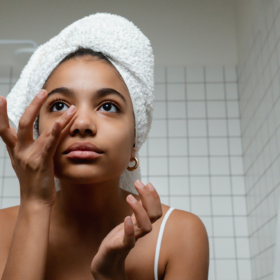
What are the causes of bacterial vaginosis?
In this article
What's the lowdown?
Bacterial vaginosis (BV) is caused by an imbalance of the normal bacteria in the vagina and can cause white, greyish or green discharge. It has a distinctive fishy smell
Bacterial vaginosis is not an STI
Effective treatment for BV is available from your regular doctor or nurse, or your local sexual health clinic
Try to avoid heavily perfumed products or intimate washes to help stave off bacterial vaginosis
What is bacterial vaginosis?
Bacterial vaginosis, or BV, is caused by a change in the natural balance of bacteria found in the vagina. Why this happens, we’re not too sure. But there are things that can increase the chances of BV. Firstly though, let’s get one thing straight: BV is NOT an STI.
What are the symptoms of bacterial vaginosis?
BV is really common, but only 50% of people with BV will show symptoms. These can include:
- Watery, thin discharge that is white, grey or green in colour
- A fishy smell that can become stronger after sex
There’s something fishy going on here
BV comes with a defining characteristic: a fishy smell. For some, it may be so bad that it is noticeable even through clothing. It can also be made worse by sex and your period. It all comes down to the vagina’s pH – how acid or alkali the vaginal environment is. The vagina should be naturally acidic, meaning it has a LOW pH. If the pH rises aka, the vagina becomes more alkaline, this can be a trigger for BV and that fishy smell. As sperm and blood are both alkaline, they increase the pH in the vagina, thereby sometimes increasing the smell.
What are the causes of bacterial vaginosis?
The vagina is a sensitive thing: the goldilocks of the body, if you will. The vagina likes the pH not too high, but not too low – it should be just right. If something upsets the balance of the pH – it can lead to bacterial vaginosis. The vagina is naturally home to bacteria, both the good and the bad. The most common of the ‘good’ bacteria is known as lactobacilli, which keeps your vagina acidic. These bacteria coexist in a happy balance, but when the bad ones increase in numbers, so too does the pH, making the environment more alkaline. This change in normal vaginal flora is the cause of bacterial vaginosis and its symptoms.
Now, there’s not one type of bacteria that causes BV; it’s more of a change in numbers of the bacteria that are already there – or the introduction of new ones from other parts of the body, be that yours or someone else’s. This is why BV is not a sexually transmitted infection, as it’s not a single bacteria that causes the infection. It’s simply a change and potential upset of the natural balance of the vagina. There are also a number of things that are thought to increase your chances of getting bacterial vaginosis…
Having sex
Being sexually active with new or multiple partners can increase your risk of getting BV due to the introduction of different bacteria from your sexual partner(s). The presence of an IUD (intrauterine device), or copper coil, could also mean your risk of getting BV is higher.
It’s possible to pass on BV from one vagina to another during sex, so if you think you have BV and have a sexual partner(s) who also has a vagina, make sure you communicate this with them as they may also need treatment. Receiving oral sex can also put you at greater risk of bacterial vaginosis.
Not using a condom
Now, we mentioned earlier that BV is NOT a sexually transmitted infection. And while that’s true, sex can increase your risk of developing BV. So too can sex without a condom. This comes back to the pH levels of your vagina and your partner’s sperm. Your vagina is kept at its healthy, slightly acidic pH by the healthy bacteria within it. Sperm, on the other hand, is alkaline. So when the two meet – as they do during unprotected sex – the vaginal pH can rise. And this can increase your risk of BV. Having BV can also increase your chances of catching an STI. So use those condoms, people!
Scented products and vaginal douching
The vagina is self-cleaning and only needs to be washed with warm water externally around the vulva. Anything more than that has the potential to irritate the vagina. Vaginal douching and other vaginal ‘hygiene’ products are not recommended by medical professionals. Products like bubble bath, scented shower gels and soaps, as well as strongly perfumed washing detergents can all disrupt the delicate balance of natural vaginal flora leading to BV.
Smoking
You’re probably thinking, ‘what does smoking have to do with my vagina?’. It’s recommended you steer clear of smoking in general to maintain good overall health, but a little known fact is that smoking actually encourages the production of the bad bacteria that causes bacterial vaginosis and that distinctive fishy smell. Smoking also stops vaginal tissue from responding to oestrogen. You’ve most likely heard of oestrogen, but did you know that it helps to maintain strong and healthy vaginal tissue?

What is the treatment for bacterial vaginosis?
Often, bacterial vaginosis will clear up on its own, but if you want to get rid of that fishy smell ASAP, or find it’s just not going away, there are treatments available. Treatment for bacterial vaginosis comes in the form of tablets, creams or gels.
Lactic acid gel
Using lactic acid gel creates an acidic environment in the vagina, encouraging the growth of the naturally occurring lactobacilli and can clear up BV in a few days. The gel also contains glycogen, which provides nutrients to these bacteria to help them grow. It is a great option for those looking to avoid antibiotics, as the gel is able to work locally. Relactagel – the BV gel treatment you’ll be able to purchase from a pharmacy – can be used for both the treatment and prevention of bacterial vaginosis.
Antibiotics
Antibiotic tablets have a high success rate in the treatment of BV, but 15-30% of women will experience a recurrence within 3 months of antibiotic treatment. And of those already experiencing recurrences, the initial success rate seems to be lower. Antibiotics also disrupt the good bacteria in the vagina and so can lead to recurring BV or even thrush. You may find a combined approach works best for you; using over the counter lactic acid gels to maintain the normal pH level and encourage the good lactobacilli, and prescription antibiotics on top of this if needed.
When to see a doctor
If you’re pregnant and you suspect you have BV, speak to a healthcare professional, like your GP or midwife. Bacterial vaginosis can increase your risk of complications during pregnancy, including premature birth and miscarriage. For this reason, they will usually recommend treatment in pregnancy. But for most, BV will cause no issues at all.
If you find that you have recurring bouts of BV, discuss with a healthcare professional the option of longer treatment to avoid it returning in the future.
Our speak to a doctor service is a convenient way to talk to a women’s health GP at a time that suits you. Our medical team are available to talk about treatment options and can help you identify a possible trigger for your BV.
We musn’t overlook the psychological impact of recurrent bacterial vaginosis. The symptoms can be distressing and embarrassing, and may be misunderstood. Recurrence rates show that of the women who were successfully treated for BV, 52% had at least one further occurrence. If bacterial vaginosis recurs, it may be necessary to restart treatment and continue for a longer period of time – up to six months if needed – to avoid a recurrence of BV. You can discuss this with your healthcare professional or local sexual health clinic, who can advise how long treatment is necessary.
Our medical review process
This article has been medically reviewed for factual and up to date information by a Lowdown doctor.



